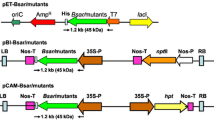Abstract
Glyphosate, a powerful nonselective herbicide, acts as an inhibitor of the activity of the enzyme 5-enoylpyruvylshikimate-3-phosphate synthase (EPSPS) encoded by the aroA gene involved in aromatic amino acid biosynthesis. An Escherichia coli mutant AKM4188 was constructed by insertion a kanamycin cassette within the aroA coding sequence. The mutant strain is an aromatic amino acids auxotroph and fails to grow on M9 minimal media due to the inactive aroA. A DNA metagenomic library was constructed with samples from a glyphosate-polluted area and was screened by using the mutant AKM4188 as recipient. Three plasmid clones, which restored growth to the aroA mutant in M9 minimal media supplemented with chloramphenicol, kanamycin, and 50 mM glyphosate, were obtained from the DNA metagenomic library. One of them, which conferred glyphosate tolerance up to 150 mM, was further characterized. The cloned fragment encoded a polypeptide, designated RD, sharing high similarity with other Class II EPSPS proteins. A His-tagged RD fusion protein was produced into E. coli to characterize the enzymatic properties of the RD EPSP protein.




Similar content being viewed by others
References
Barry GF, Kishore GM, Padgette SR (1992) DNA encoding class II 5-enolpyruvyl shikimate-3-phosphate synthase—for producing plants and bacteria tolerant to glyphosate herbicides. World Patent WO 9, 204,449
Barry GF, Kishore GM, Padgette SR, et al. (1992) Inhibitors of amino acid biosynthesis: strategies for imparting glyphosate tolerance to crop plants. In: Singh BK, Flores HE, Shannon JC (eds) Biosynthesis and molecular regulation of amino acids in plants. American Society of Plant Physiologists, Rockville, MD Pages 139–145
Bradford MM (1976) A rapid and sensitive method for the quantitation of microgram quantities of protein utilizing the principle of protein-dye binding. Anal Biochem 72:248–254
Comai L, Sen LC, Stalker DM (1983) An altered aroA gene product confers resistance to the herbicide glyphosate. Science 221:370–371
Copeland RA (2000) Enzymes: A practical introduction to structure, mechanism and data analysis. Wiley-VCH, New York, pp 109–145
Datsenko KA, Wanner BL (2000) One-step inactivation of chromosomal genes in Escherichia coli K-12 using PCR products. Proc Natl Acad Sci USA 97:6640–6645
Dower WJ, Miller JF, Ragsdale CW (1988) High efficiency transformation of E. coli by high voltage electroporation. Nucleic Acids Res 16:6127–6145
Eschenburg S, Healy ML, Priestman MA, et al. (2002) How the mutation glycine96 to alanine confers glyphosate insensitivity to 5-enolpyruvyl shikimate-3-phosphate synthase from Escherichia coli. Planta 216:129–135
Fitzgibbon JE, Braymer HD (1990) Cloning of a gene from Pseudomonas sp. strain PG2982 conferring increased glyphosate resistance. Appl Environ Microbiol 56:3382–3388
Funke T, Han H, Healy-Fried ML, et al. (2006) Molecular basis for the herbicide resistance of Roundup Ready crops. Proc Natl Acad Sci USA 103:13,010–13,015
He M, Yang ZY, Nie YF, et al. (2001) A new type of class I bacterial 5-enopyruvylshikimate-3-phosphate synthase mutants with enhanced tolerance to glyphosate. Biochim Biophys Acta 1568:1–6
Lanzetta PA, Alvarez LJ, Reinach PS, et al. (1979) An improved assay for nanomole amounts of inorganic phosphate. Anal Biochem 100:95–97
Liu Z, Lu W, Chen M, et al. (2006) Genetic analysis of glyphosate tolerance in Halomonas variabilis strain HTG7. World J Microbiol Biotechnol 22:681–686
Notredame C, Higgins DG, Heringa J (2000) T-Coffee: A novel method for fast and accurate multiple sequence alignment. J Mol Biol 302:205–217
Padgette SR, Re DB, Gasser CS, et al. (1991) Site-directed mutagenesis of a conserved region of the 5-enolpyruvylshikimate-3-phosphate synthase active site. J Biol Chem 266:22,364–22,369
Priestman MA, Funke T, Singh IM, et al. (2005) 5-Enolpyruvylshikimate-3-phosphate synthase from Staphylococcus aureus is insensitive to glyphosate. FEBS Lett 579:728–732
Sambrook J, Russel D (2001) Molecular cloning: A laboratory manual, 3rd ed. Cold Spring Harbor Laboratory Press, Plainville, NY
Sambrook J, Fritsch EF, Maniatis T (1989) Molecular cloning: A laboratory manual, 2nd ed. Cold Spring Harbor Laboratory Press, Plainville, NY
Sikorski JA, Gruys KJ (1997) Understanding glyphosate’s molecular mode of action with EPSP synthase: evidence favoring an allosteric inhibitor model. Acc Chem Res 30:2–8
Streit WR, Schmitz RA (2004) Metagenomics: the key to the uncultured microbes. Curr Opin Microbiol 7:492–498
Sun YC, Chen YC, Tian ZX, et al. (2005) Novel AroA with high tolerance to glyphosate, encoded by a gene of Pseudomonas putida 4G-1 isolated from an extremely polluted environment in China. Appl Environ Microbiol 71:4771–4776
Yanisch-Perron C, Vieira J, Messing J (1985) Improved M13 phage cloning vectors and host strains: nucleotide sequences of the M13mp18 and pUC19 vectors. Gene 33:103–119
Acknowledgments
This work was supported by the Ministry of Science and Technology of China (National Basic Research Program No. 2007CB707805) and the National Natural Science Foundation of China (grant Nos.30470047 and 30200007).
Author information
Authors and Affiliations
Corresponding authors
Rights and permissions
About this article
Cite this article
Jin, D., Lu, W., Ping, S. et al. Identification of a New Gene Encoding EPSPS with High Glyphosate Resistance from the Metagenomic Library. Curr Microbiol 55, 350–355 (2007). https://doi.org/10.1007/s00284-007-0268-x
Received:
Accepted:
Published:
Issue Date:
DOI: https://doi.org/10.1007/s00284-007-0268-x




